|
Botany
The Roots
- The palm has adventitious roots continually produced from the base of the trunk, which is the swollen part or what is termed 'bole', in tall types and in some dwarf hybrids.
- It has no taproot or root hairs but has lots of primary roots which bear large quantities of rootlets.
- The main roots grow out somewhat horizontally from the bole and are mostly found within the topsoil. The main branches grow deeper and may extend laterally to as much as 10 m.
- The roots, having no cambium, are noticeably uniform - the main roots reaching a maximum diameter of about 1 cm. The root tip is the actively growing region and behind it is the absorbing area whose epidermis is a single layer of thin-walled cells that gradually thicken and become impervious with age.
- In old roots, the epidermis disintegrates and exposes the hard hypodermis which is generally red.
- The root centre has a stele surrounded by a single-celled pericycle sheath from which rootlets and aerenchymatous (respiratory exchange) protuberances or pneumatophores arise. The respiratory exchange occurs more abundantly nearer the soil surface to allow easy diffusion of root.
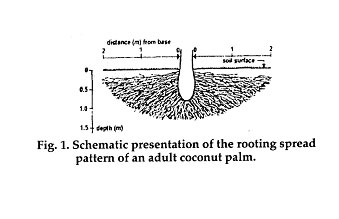 
Coconut Root System
Stem
- The stem is called as trunk
- It is unbranched, erect, stout and cylindrical
- The leaf base encircles the stem as they have scars with pit mark on the trunk
- The scars are helpful in determining the age of the tree. Based on these 12 to 14 scars, the age can be computed for a year
- First few years there is increased growth in the thickness of the stem
- The girth remains uniform for a number of years and finally tapers in growth when the tree grows very old
- The trunk carries a big crown with large sized leaves and bunches of fruits
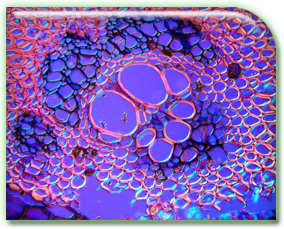
Transverse Section of Coconut Stem |
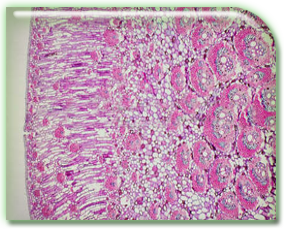
Light Micrograph of a Transverse Section of Coconut Stem |
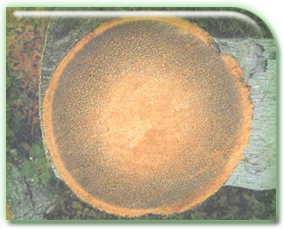
Cross Section of Coconut Stem at Breast Height |
| |
|
|
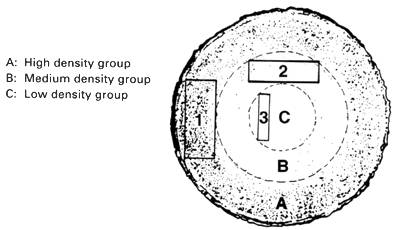 Cross Section of Coconut Stem with Cross Section of Coconut Stem with
Density Zones |
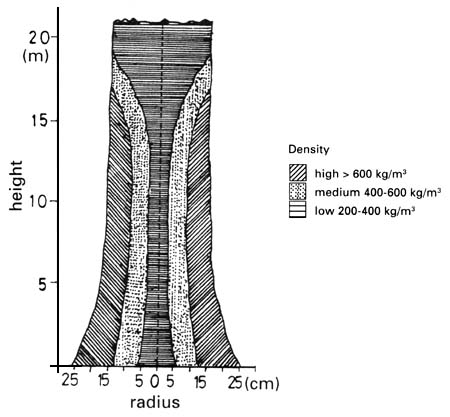 Schematic Density Distribution in Mature Coconut Stem Schematic Density Distribution in Mature Coconut Stem
|
 Use of the Coconut Stem Use of the Coconut Stem |
Leaf
- The leaves are crowded together at the top of the trunk in the form of a crown
- The young leaf appears in the centre of the crown as a pointed structure having all the leaves closely held together
- It takes five months for the complete development of a leaf from the time of initiation to its complete emergence
- The crown has 15 open leaves, 15 younger leaves in different stages of development
- The leaf consists of many leaflets arranged obliquely on the mid-rib or rachis
- Each leaflet is long, linear, has a strong mid-rib with narrow lamina and parallel venation
- The petiole is flat, very thick, broad and sheathe with fibre at the base and encircles the stem
|

Coconut Leaf |
Inflorescence
- It takes 34 months for the inflorescence to develop from the initiation to the opening of the spathe
- The spadix is stout and erect, enclosed by the tough spathe which splits when inflorescence is mature
- The axis of the inflorescence is branched, with the branches bearing sessile flowers, both staminate and pistillate
- The palm is monoceious with male and female flowers on the same plant
- Staminate flowers are small, numerous and are arranged closely on the secondary branches of the inflorescence
- They have six perianth lobes in two whorls and the outer perianth are small, the inner perianth is bigger
- Stamens are six and plenty of pollen is produced. An abortive psitillate or rudimentary ovary is present in the staminate flower. The pollen grains are spherical in shape and are smooth
- Pistillate flowers are at about the base of the branches substened by one or two staminate flowers
- They are small spherical structure known as ‘button’
- Six perianth lobes in two whorls arranged imbricate and more or less of the same size and shape
- The perianth is rounded, concave and whitish, the stigma is found at the base of the ovary
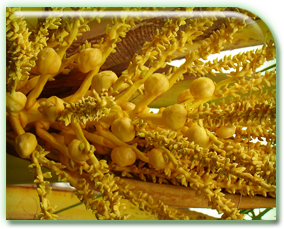
Coconut Inflorescence |
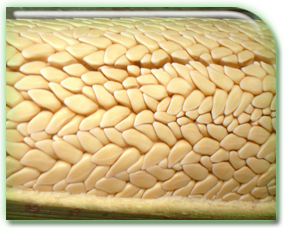
Coconut Flower Inside View |
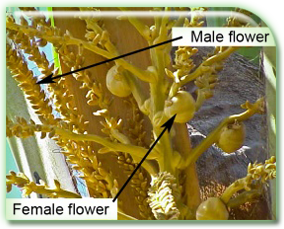
Male and Female Flower |
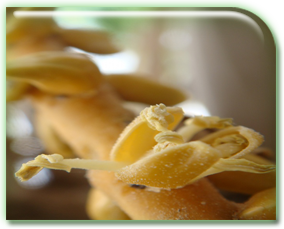
Coconut Flower - Close View |
Fruit
- Once pollination and fertilization occur, fruits set and develop to maturity in about 12 months, or less than 1 year for some dwarf cultivars. A count of bunch and fruit set can give a reasonable estimate of yield.
- Fruit is drupe, having three regions and one seeded .On the outside is the husk
- The fruit is developed from a tricarpellary ovary
- The outer layers of pericarp are fibrous called as husk which is initially green but turns brown after being picked and dried.
- The endocarp is very hard and forms the shell
- Within the endocarp, soft white endosperm enclosing inside a big cavity filled with extra-cellular fluid called as "coconut milk." The seed coat, which is thin, and then the white flesh or copra. Both the copra and the milk are the endosperm of this seed
- Initially the milk is fairly sweet and the copra is thin, but as the seed matures, the liquid is converted into solid endosperm rich in oils (triglycerides)
- The endosperm or the kernel also contains sucrose, fructose, galactose, glucose and raffinose
- The moisture content in the kernel diminishes as the maximum quantity of oil is formed when the nuts are 9-10 months old
- Liquid endosperm contains large quantities of cytokinin hormone which is useful to grow plants in test tubes from single cells and this develops into embryos

Immature Coconut Fruit |

Young Coconut |
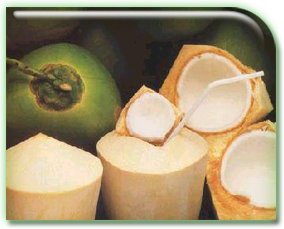
Tender Coconut |

Mature Coconut Fruit |
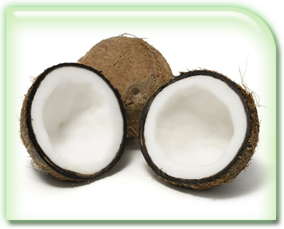
Raw Coconut Cross |

Section of a Coconut |
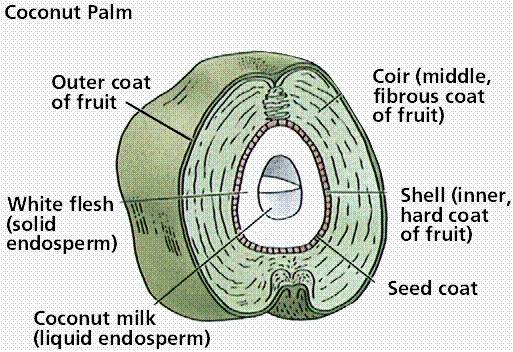
Coconut Endosperm |
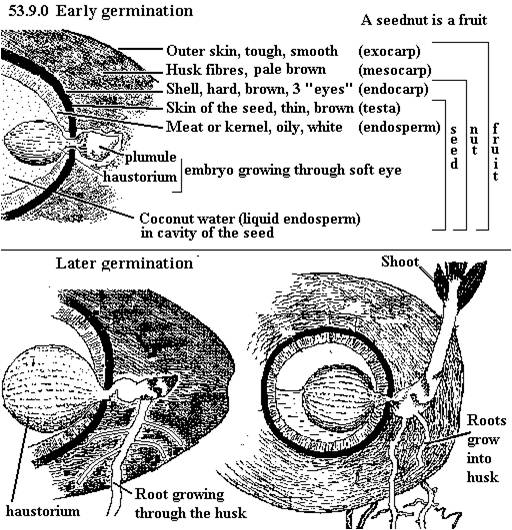
Comparison of Early and Late Germination |
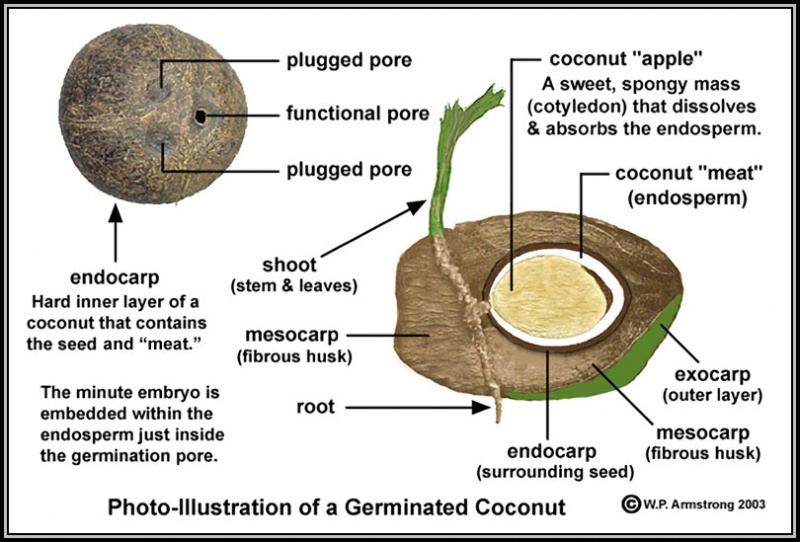
Photo Illustration of a Germinated Coconut |
Varieties
List of Tall Varieties
List of Dwarf Varieties (Tender coconut)
List of Hybrid Varieties
| Variety |
Main Characteristics |
Germination |
Examples |
| Talls |
Thick stem with swollen base (bole). Late flowering (5–6 year from out planting). Little or no overlapping of male and female phases of an inflorescence encouraging out crossing |
Early |
‘Malayan Tall’, ‘Bali Tall’, ‘Tagnanan Tall’, ‘San Ramon Tall |
| Late |
‘West African Tall’, ‘Rennel Tall’, ‘Samoan Tall’, ‘Polynesian Tall’, ‘Solomon Tall’, ‘Vanuatu Tall’, ‘Gazelle (PNG) Tall’, ‘Jamaica Tall’, ‘Panama Tall’ |
| Dwarfs |
Slender stem with short internodes. Bole slight or absent. Early flowering (3 year from out planting). Considerable overlapping of male and female phases of an inflorescence resulting in self-pollination |
Intermediate |
‘Malayan Red’, ‘Yellow’ and ‘Green’ Dwarfs, ‘Cameroon Red’ Dwarf, ‘Nias Green’ and ‘Nias Yellow’ Dwarfs, ‘PNG Brown’ Dwarf, ‘Samoan Yellow’ Dwarf’ |
| Intermediate |
‘Niu Leka’, also known as ‘Fiji Dwarf ’ and ‘Samoan Dwarf’ |
Soil
Light sandy soils to heavy soils with a pH - 5.2 to 8.0. Proper drainage, good water-holding capacity, presence of water table within 3 m and absence of rock or any hard substratum within 2 m of the surface.
Altitude: 600 to 900 m
Rainfall: 200 cm per year.
Planting seasons
June - July, December - January
The planting can also be taken up in other seasons wherever irrigation and drainage facilities are available.
Planting Material
Selection of Seed Gardens
- Gardens should have palms with a high proportion of heavy bearers but it should be kept in mind that this must not be from very favourable conditions Garden should be free from the pest and disease incidence.
- Trees growing closer to households, cattle shed, compost pits should be avoided.
- Certain centres are well known for good quality seed nuts and seedlings, e.g., in Kerala, Kuttiadi in Kozhikode and Chavakkad in Thrissur districts.
Mother Palm Selection
For production of quality planting materials it is essential to have good quality mother palms of the desired varieties. In the absence of commercially viable vegetative propagation techniques only seed propagation is possible. Therefore mother palm selection is a key factor in planting material production of coconut.
The important features of superior mother palms are:
- Regular bearer : A good regular bearing mother palm produces on an average one leaf and an inflorescence in its axil every month. So, there will be twelve bunches of varying stages of maturity at any one time with strong bunch stalks. Avoid trees producing habitually barren nuts.
- Straight stout trunk with even growth and closely spaced leaf scars.
- Spherical or semi spherical crown,
- High rate of leaf (more than 30 fully opened leaves) and spathe production (12 inflorescences)
- Short and stout petiole and wide leaf base firmly attached to the stem,
- Short and stout inflorescence stalk with bunches, preferably resting on the leaf petioles of the lower whorl and more number of female flowers (25 or more)
- The age of the palm chosen be middle age i.e., from 25 to 40 years. Even trees with 15 years age can be selected, if it is high yielding and has stabilized yield.(e.g., Chowghat dwarf). Avoid palms that are above 60 years.
- High yielding mother palms giving not less than 100 nuts/palm/annum under irrigated condition (70-80 nuts/annum under rain fed conditions) should be chosen for collecting seednuts
- Husked nuts should weigh not less than 600 g.
- Mean copra content of 150 g per nut or more
- Free from pest and diseases.
Avoid palms which have the following characteristics
- Palms have long, thin and pendulous inflorescence stalks
- Palms produce long, narrow, small sized or barren nuts
- Palms showing alternate bearing tendency also should be avoided.
- Palms show shedding of immature nuts in large numbers and
- Palms are grown under favorable environmental conditions. E.g. Trees near manure pits.
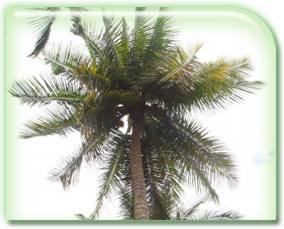
Ideal Mother Palm |
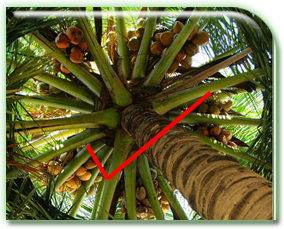
Healthy Coconut Palm |

Regular Bearer |

Unhealthy Coconut Palm |
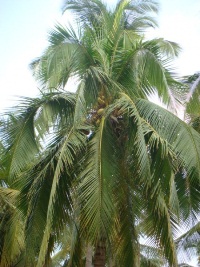
High Rate Leaves |
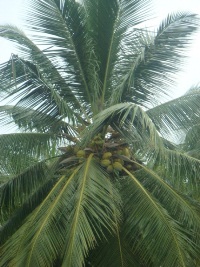
Spherical Crown |
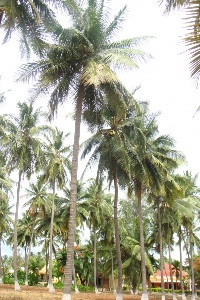
Straight Stout Trunk |
Strategies for Root Wilt Diseased Tracts
In the root wilt disease prevalent tracts, in the midst of heavily diseased palms, high yielding disease free West Coast Tall (WCT), Chowghat green dwarf (CGD) and Chowghat Orange Dwarf (COD) palms are found. Such palms can be selected as mother palms and open pollinated nuts of those palms can be used for large scale planting material production. Seedlings produced from these palms are expected to be high yielding and disease free.
Maturity of Seed Nut
The mature nuts are harvested when at least one nut in the oldest bunch starts becoming dry. In Tall varieties, it takes 11-12 months to become a matured seed nut whereas in dwarfs, nuts will mature in 10-11 months after emergence of the inflorescence. They produce a resonant and ringing sound when hit with the harvesting knife or tapped by finger indicating that the husk is dry. Immature nuts will produce a dull sound. Harvest the bunches intended for seed nut by lowering them to the ground using a rope to avoid injury to seed nuts when palms are tall and ground is hard. The seed nuts should be medium sized, round or oblong in shape.
Selection of Seed Nuts
Harvest seed nuts during the months of February - August in Tamil Nadu, December to May in Kerala to get maximum germination and good quality seedlings. Tall varieties are sown one or two months after collection whereas dwarfs should be sown immediately after harvest (within 10 to 15 days).

Healthy Coconut Fruits |

Selected Healthy Nuts |
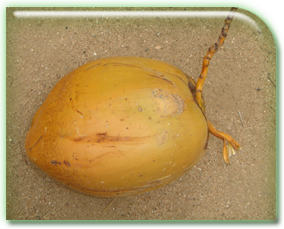
Ideal Seed Nut |
| |
|
|

Immature and Disease Affected Coconut Fruits |

Disease Infested Coconut Fruits |

Discarded Seed Nuts |
Storage of Seed Nuts
To get more quality seedlings, the seed nuts of tall and hybrid are to be air cured for one month followed by sand curing for two months. For dwarf varieties, the air curing should be lesser than one month followed by sand curing for two months. In general seed nuts of tall variety are stored up to two months after harvest and dwarfs are sown within 15 days. For storing, arrange the seed nuts with the stalk-end up over an 8 cm layer of sand in a shed and cover with sand to prevent drying of nut water. Up to five layers of nuts can be arranged one over the other. The nuts can also be stored in plots, provided the soil is sandy and the ground is sufficiently shaded. In the case of nuts harvested in May, heap them in partial shade, till husk is well dried and then sow them in the nursery. Nuts without splashing sound indicate that the nut water has become dry and hence they should not be used for sowing.
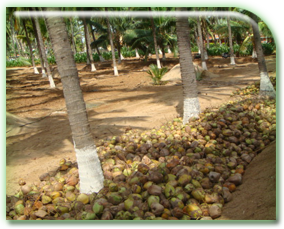
Shaded with Coconut Tree |

Good Storage of Nuts |
Seed Nut Dipping - Dipping in Copperoxychloride (COC)
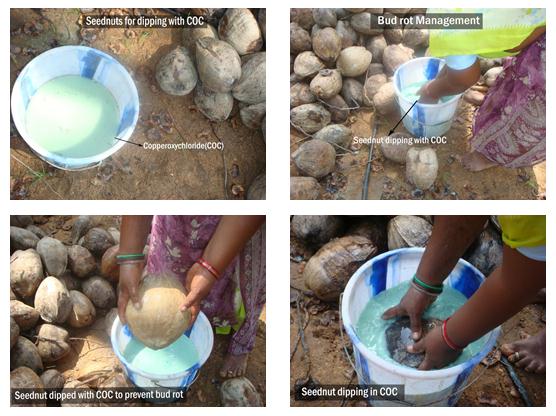 Seed Nut Dipping Seed Nut DippingNursery management
Nursery Area
- Select nursery area in a well drained plot with coarse texture soil near water source for irrigation. Nursery can be raised in the open space with artificial shade or in the adult coconut garden.
| Nursery Bed Preparation |

1.5 m Width with Convenient Length |
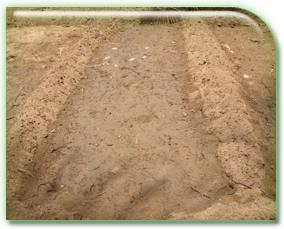
75 cm Space Between Beds |
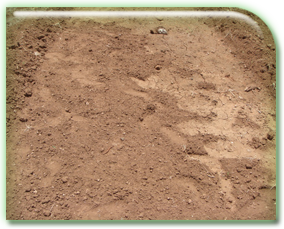
Levelled Beds |
| |
|
|
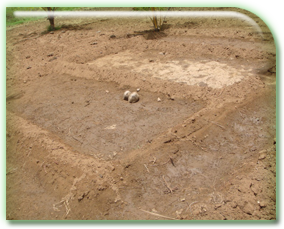
Small Length Sized Beds |
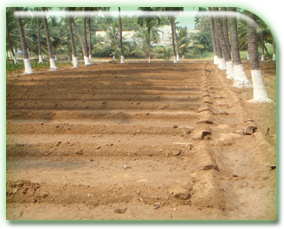
Well Prepared Nursery Beds |
| |
| Nursery Structure |
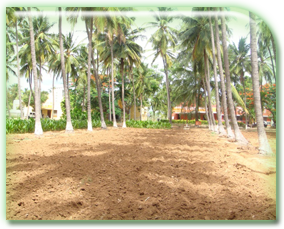
Nursery Area between Coconut |
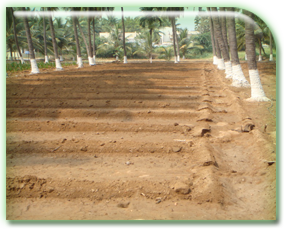
Raised Nursery Bed |

50 % Shaded Nursery |
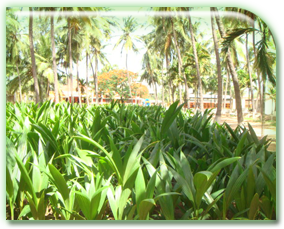
Nursery under Partial Shade in Coconut Plantation |
Seed Nut Planting
- Plant seed nuts in a long and narrow bed at a spacing of 30 x 30 cm either horizontally or vertically in deep trenches with 20-25 cm depth. Five rows of nuts may be planted in each bed accommodating 50 nuts per row.
Planting Seed Nuts

Prepared Bed for Planting |
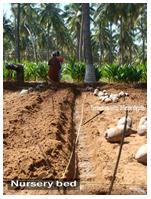
Nursery Bed |

Bed Preparation |
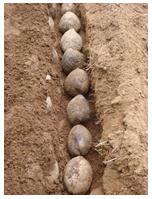
Planting Seed Nuts Properly |
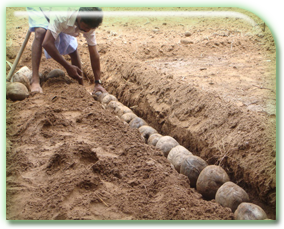
Placing Seed Nuts Horizontally |
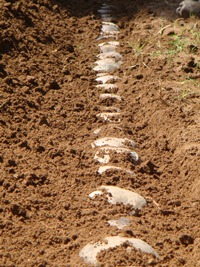
Top Portion of Nuts Visible |

Seedling Growth from Top Portion of Nuts |

Seedling Growth from Visible Portion of Nuts |
| |
|
|
|
Intercultural Operations in Nursery
- Irrigate the nursery beds once in three days.
- Keep the nursery free of weeds. To manage the weed problem in coconut nursery, growing sun hemp 2 times (each harvested at flowering stage) followed by one hand weeding at 6th month was found to be very effective besides yielding green manure for manuring the adult coconut palms.
- Provide shade to the nursery by raising Sesbania or Leucaena on the sides of beds.
- The seed nuts start germination 6 – 8 weeks after planting and germination continues upto six months. Select seedlings that germinate before 5 months after planting. Remove those nuts which do not germinate 5 months after sowing.
- Regularly survey for pest and diseases.
Selection of Seedlings
- Select seedlings 9 to 12 months after planting. Seedlings, which have germinated earlier, having good girth at collar and early splitting of leaflets, should be selected for planting.
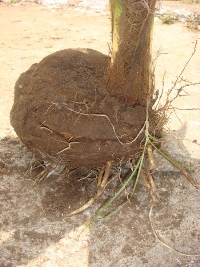
Healthy Root System |

Pest and Disease Free Seedling |
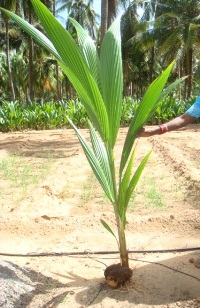
Ideal Well Growth Seedling |
Discarded Seedling
Do not select the seed nuts which have just germinated. Eliminate the seedlings which are deformed or having stunted growth.
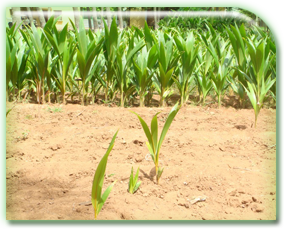
Stunted Growth Seedling
|
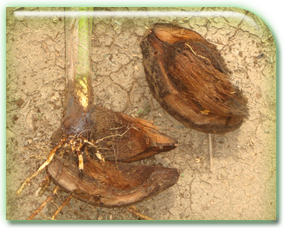
Stunted Root Growth Seedling |
Seedling Harvesting
- Remove the seedlings from the nursery by lifting with spade. Do not pull out the seedlings by pulling leaves or stem.
- Select quality seedlings with a minimum of 6 leaves and girth of 10 cm at collar.
Spacing
Adopt a spacing of 25' x 25' (7.5 x 7.5 m) with 175 plants/ha. For planting in field border as a single row, adopt 20' spacing between plants.
Planting
Dug pit size of 3’ x 3' x 3'. In the pits, sprinkle Lindane 1.3 % D to prevent white ant damage. Fill the pit to a height of two feet (60 cm) with FYM, red earth and sand mixed in equal proportions. At the center of the pit, remove the soil mixture and plant the seedling after removing all the roots. Press the soil well around the seedling and provide the seedling with shade by using plaited coconut leaves or palmyrah leaves. Keep the pits free from weeds. Remove soil covering the collar region. As the seedlings grow and form stem, fill up the pits gradually by cutting the sides.
Water management
From 5th year onwards, adopt the following irrigation schedule based on pan evaporation for drip irrigation and basin irrigation.
Western region of Tamil Nadu
| Months |
Normal condition
(for best yield) |
Moderate water scarcity condition |
Severe water scarcity condition |
| A. Drip irrigation |
| February to May |
65 lit / day |
45 lit/ day |
22 lit / day |
January, August and
September |
55 lit / day |
35 lit / day |
18 lit/day |
June and July,
October to December |
45 lit / day |
30 lit/ day |
15 lit / day |
| B. Basin irrigation |
| February to May |
410 lit / 6 days * |
|
January, August and
September |
410 lit /7 days* |
June and July,
October to December |
410 lit /9 days* |
Eastern region of Tamil Nadu
| Months |
Normal condition
(for best yield) |
Moderate water scarcity condition |
Severe water scarcity condition |
| A. Drip irrigation |
| March - September |
80 lit / day |
55 lit / day |
27 lit/day |
| October – February |
50 lit / day |
35 lit/ day |
18 lit /day |
| B. Basin irrigation |
| March – September |
410 lit / 5 days* |
|
| October – February |
410 lit /8 days* |
* Quantity of water to be applied in the basin. Add 30 - 40 % of the above quantity of water (135 -165 litres/palm) to meet the conveyance loss.
Drip irrigation in coconut
Root zone of coconut for moisture absorption is concentrated in a circular area of 200 cm radius around the base of coconut tree up to a depth of 100 cm. Irrigating coconut trees by a set of four drippers set equidistant in a circle 100 cm away from the base of the tree and discharging water at the rate of 30 l/h for 2.5 h with a irrigation frequency of 8 days can maximize the wetting area of soils in the effective root zone of coconut.

Basin system
Drought management and soil moisture conservation
a. Mulching with coconut husks/leaves/coir pith
Apply coconut husks with convex surface facing upwards (100 Nos.) or dried coconut leaves (15 Nos) or coir pith up to a height of 10 cm in the basin of 1.8 m radius around the palms as mulch for soil moisture conservation particularly during summer season.
b. Burial of coconut husk or coir pith
Husk burial can be done in coconut basins or in the interspaces to overcome drought and button shedding. Bury husks @ 100 Nos. with concave surface facing upwards or 25 kg of coir pith /palm in circular trenches, dug 30 cm width and 60 cm depth at 1.5 metres radius. The husk can be also buried in the trenches at a distance of 3 m from the palm with a size of 45 cm deep and 150 cm width in between two rows of coconut. The soaking of the coconut husk or coir pith as the case may be preserves the monsoon rains.
Manuring
| Age(Years) |
FYM(kg/tree) |
Urea(kg/tree) |
Super
Phosphate(kg/tree) |
Muriate of
Potash(kg/tree) |
| 1 |
10 |
0.308 (140 g N) |
0.500 (80 g P2O5) |
0.480 (300 g K2O) |
| 2 |
20 |
0.616 (280 g N) |
1.000 (160 g P2O5) |
0.960 (600 g K2O) |
| 3 |
30 |
0.924 (420 g N) |
1.500 (240 g P2O5) |
1.440 (900 g K2O) |
| 4 |
40 |
1.23 (560 g N) |
2.000 (320 g P2O5) |
1.920 (1200 g K2O) |
| 5th year onwards |
50 |
1.23 (560 g N) |
2.000 (320 g P2O5) |
1.920 (1200 g K2O) |
Apply manures and fertilizers in circular basins of 1.8 m from the base of the palm, incorporate and irrigate. The fertilizers may applied in two split doses, in June – July and in December to January.
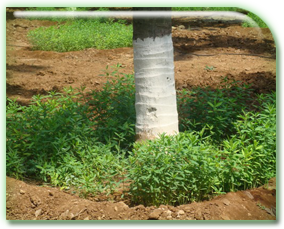 Green Manure in Coconut Green Manure in CoconutTNAU Coconut tonic
For nut bearing coconut, root feed TNAU coconut tonic @200ml/palm once in six months.
Bio-fertilizer recommendation
Mix 50 g of Azospirillum, 50 g of Phosphobacteria ( or ) 100 g Azophos and 50 g of VAM in sufficient quantity of compost or FYM and apply near feeding roots once in 6 months / palm starting from planting. Don’t mix with chemical fertilizers and pesticides
Organic recycling
Any one of the green manure crops like sunnhemp, Calapagonium or Daincha may be sown and ploughed in situ at the time of flowering as a substitute of compost to be applied. Sow sunnhemp @ 50 g/palm in the basin and incorporate before flowering. Coir pith compost/vermicompost made from coir pith/ coconut leaves/ other wastes from coconut grove can be applied.
Inter-cultural operation weed management
The inter-space in the coconut garden has to be ploughed twice in a year in June - July and December - January. Intercultural operation is essential to keep weed population under check, to enhance the utilisation of the applied plant nutrients by the coconut trees, to facilitate proper aeration to the roots of coconut, to induce fresh root growth.
Weed management
For the broad-leaved weeds, pre-emergence spraying of atrazine @1.0 kg a.i./ ha for the control of grasses and sedges. Post emergence spraying of glyphosate @ 10 ml and 20 g ammonium sulphate/litre of water.
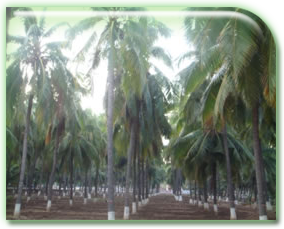
Weed free coconut garden
Inter cropping
Inter/mixed crops may be selected based on the climatic requirement of the inter/mixed crop, irrigation facilities and soil type. The canopy size, age and spacing of the coconut are also to be considered. Market suitability should be taken into consideration before selecting an intercrop.
A. Below 7 years of age: Any suitable annual crop for particular soil type and climatic condition may be raised as intercrops upto 5 years after planting depending upon the canopy coverage. Groundnut, sesamum, sunflower, tapioca, turmeric and banana can be grown. Avoid crops like paddy and sugarcane etc.
B. 7 – 20 years of age: Green manure crops and fodder crops (Napier grass and guinea grass) alone can be grown.
C. Above 20 years of age (20 years of age has to be adjusted based on the sunlight transmission of above 50% inside the canopy): The following crops can be grown depending on the soil and climatic suitability.
Annuals: Groundnut, bhendi, turmeric, tapioca, sweet potato, sirukizhangu, elephant foot yam, ginger, pineapple
Biennials: Banana varieties Poovan and Monthan are suitable.
Perennials: Cocoa*, pepper*(Panniyur 1 or Panniyur 2 or Panniyur 5 or Karimunda), nutmeg* and vanilla*
*Suitable areas in Pollachi tract of western region and Kanyakumari district. For vanilla, use disease free planting material and maintain high vigilance to maintain a disease free crop.
Multiple cropping system
Coconut + banana + sirukizhangu + bhendi is suitable system for the eastern region. Crops like banana, pepper, cocoa, nutmeg, vanilla can be tried under multiple cropping system in suitable areas in the western region. In all the systems, apply recommended quantity of water and manures and fertilizers to the intercrops separately.

Intercropping with Banana |
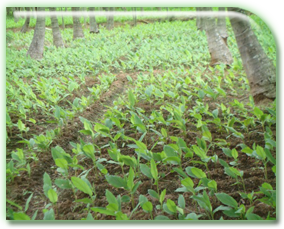
Intercropping with Turmeric |

Intercropping with Arecanut |

Intercropping with Tapioca |
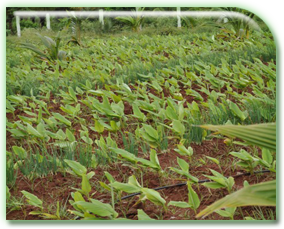
Intercropping with onion & Turmeric |

Intercropping with Maize |
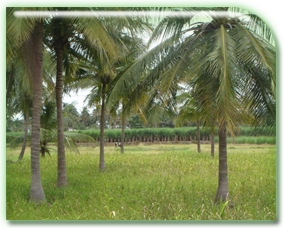
Intercropping with Sorghum |
|
| |
Harvesting
- Twelve months old nuts are harvested at the interval of 30-45 days for seed as well as copra making and culinary purposes.
- For household use keep the nuts in vertical direction. However, for tender nut purposes 7 to 8 months old nuts are harvested. The nuts can be harvested using coconut climbers.
- Nuts which are 11 months old give fiber of good quality. This is suitable for coir fiber.
- In case of tall the nuts harvested for seed purpose can be stored for 2 to 3 months period before sowing, whereas in case of dwarfs and hybrids, nuts should be sown with in a period of 10 –15 days of harvest.
- On an average, we can have eight harvests, though the coconut palm produces inflorescence every month.

Coconut Harvesting Equipments
(Traditional Method) |
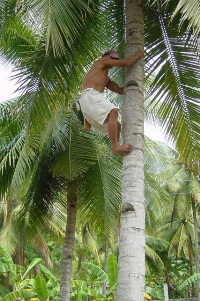
Coconut Harvest |

Collecting of Harvested Coconuts |
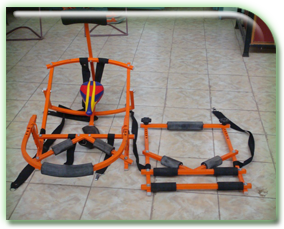
Tree Climber |

Harvesting by Tree Climber |

Coconut Dehusker |
| |
Marketing
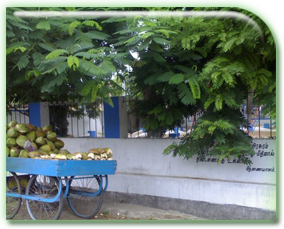
Mobile Marketing |
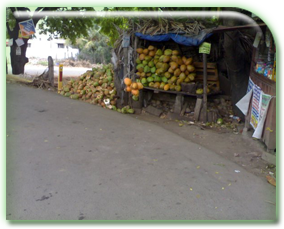
Road Side Market |

Regulated Market |
Yield
| S.No |
Variety |
Nut yield (Nos / tree / year) |
Earlyness (year) |
| 1 |
Hybrid |
100 |
3 - 5 |
| 2 |
Tall |
60 - 80 |
6 - 7 |
| 3 |
Dwarf (tender coconut) |
70 - 90 |
4 - 5 |
Pest and disease management
A. Pest management
| Pests |
Management strategies |
|
Rhinoceros beetle
Oryctes rhinoceros
|
- Remove and burn all dead coconut trees in the garden (which are likely to serve as breeding ground) to maintain good sanitation.
- Collect and destroy the various bio-stages of the beetle from the manure pits (breeding ground of the pest) whenever manure is lifted from the pits.
- Incorporate the entomopathogen i.e, fungus (Metarrhizium anisopliae) in manure pits to check the perpetuation of the pest.
- Soak castor cake at 1 kg in 5 l of water in small mud pots and keep them in the coconut gardens to attract and kill the adults.
- Treat the longitudinally split tender coconut stem and green petiole of fronds with fresh toddy and keep them in the garden to attract and trap the beetles.
- Examine the crowns of tree at every harvest and hook out and kill the adults.
- For seedlings, apply 3 naphthalene balls/palm weighing 3.5 g each at the base of inter space in leaf sheath in the 3 inner most leaves of the crown once in 45 days.
- Set up light traps following the first rains in summer and monsoon period to attract and kill the adult beetles.
- Field release of Baculovirus inoculated adult rhinoceros beetle @ 15/ha reduces the leaf and crown damage caused by this beetle.
- Apply mixture of either neem seed powder + sand (1:2) @150 g/palm or neem seed kernel powder + sand (1:2) @150 g per palm in the base of the 3 inner most leaves in the crown
- Set up Rhinolure pheromone trap @ 1/ 2 ha to trap and kill the beetles.
|
Black headed caterpillar
Opisina arenosella |
- The incidence of the pest is noticed from the month of November to May and from August to November after rainfall. The coconut trees of all ages are attacked.
- Release the larval (Bethylid, Braconid and Ichneumonid) and pupal (Eulophid) parasitoids and predators periodically from January, to check the build up of the pest during summer.
- Among the larval parasitoids, the bethylid Goniozus nephantidis is the most effective in controlling the pest. The optimum level of release is 1:8 of host-parasitoid ratio. The parasitoid should be released @3000/ha under the coconut trees when the pest is in the 2nd or 3rd instar larval stage. Parasitoids should not be released in the crown region since they will be killed by predators like spiders and reduviid bugs.
- Remove and burn all affected leaves/leaflets.
- Spray Malathion 50 EC 0.05% (1mi/lit) to cover the undersurface of the leaves thoroughly in case of severe epidemic outbreak of the pest in young palms.
- Root feeding for the control of coconut Black headed caterpillar: Select a fresh and live root, cut sharply at an angle and insert the root in the insecticidal solution containing Monocrotophos 36 WSC 10 ml + water 10 ml in a 7 x 10 cm polythene bag. Secure the bag tightly to the root with a cotton thread. Twenty four hours later, check whether there is absorption. If there is no absorption select another root. These methods should not be resorted to as a routine practice and it is suggested only for cases of severe epidemic outbreak of the pest and when the survival of the tree is threatened.
|
|
Red palm weevil
Rhynchophorus ferrugineus
|
- Remove and burn all wilting or damaged palms in coconut gardens to prevent further perpetuation of the pest.
- Avoid injuries on stems of palms as the wounds may serve as oviposition sites for the weevil. Fill all holes in the stem with cement.
- Avoid the cutting of green leaves. If needed, they should be cut about 120 cm away from the stem.
- Plug all holes and inject Pyrocone E or Carbaryl 1% or 10 ml of Monocrotophos into the stem by drilling a hole above the points of attack.
- Setting up of attractant traps (mud pots) containing sugarcane molasses 2½ kg or toddy 2½ litres + acetic acid 5 ml + yeast 5 g + longitudinally split tender coconut stem/logs of green petiole of leaves of 30 numbers in one acre to trap adult red palm weevils in large numbers.
- Root feeding: As under black headed caterpillar
|
|
Termites
Odontotermes obesus |
- Locate termite mounds in or near the coconut nursery or garden and destroy.
- Swabbing with neem oil 5% once on the base and upto 2 m height of the trunk for effective control.
- Spray Copper sulphate 1 % or Cashew nut shell oil 80 % followed by Copper sulphate 1 % then neem oil 5 % and copper sulphate 1 %, then NSKE 20 % to preserve planted coconut leaves from the termite attack.
|
|
Scale insect
Aspidiotus destructor |
- Pluck mature nuts and spray Monocrotophos 36 WSC 1 ml/ha.
- Do not harvest nuts for 45 days after spraying.
|
|
Mealy bugs
Pseudococcus longispinus |
- Remove leaflets harbouring these insects and destroy them
Spray any one of the following :
- Malathion 50 EC 2 ml/lit (or)
- Dimethoate 30 EC 1 ml/lit (or)
- Methyl demeton 25 EC 1 ml/lit (or)
- Phosphamidon 40 SL 1.25 ml/lit (or)
- Monocrotophos 36 WSC 1 ml/lit (or)
- Methomyl 25 EC 1 ml/lit (or)
- Neem oil 3% (or)
|
|
Leaf caterpillars
Turnaca acuta |
- Collect and destroy the immature stages of the insects wherever possible and spray Carbaryl 0.1 %. A combined treatment of root feeding of Monocrotophos at 5 ml + 5 ml water, spraying of 0.01% Monocrotophos followed by the release of Parasitoids at every 15 days interval of time effectively control leaf eating caterpillars.
|
|
Nut caterpillar |
|
Nut coreid bug |
|
Slug caterpillar
Contheyla rotunda |
Spray any one of the following:
- Dichorvos 76 WSC 2 ml/lit
- Bacillus thuringiensis 2 g/lit,
- Triazophos 40 EC 5 ml
- Methyl demeton 25 EC 4 ml/lit
- Root feeding with monocrotophos 15 ml + 15 ml of water
|
|
Scolytid bark borer beetles
Xyleborus parvulus |
- Stem injection through a stove wick soaked in 0.2% fenthion or 0.2% dichlorvos and plugging the hole and repeating the treatment using the same wick and hole a month after.
|
|
Palm civet
Vivera zibatha
|
- Poison baiting with ripe banana fruit sandwiched with 0.5 g carbofuran 3 G granules.
|
|
Rat
Rattus rattus wroughtoni |
- Tree banding with inverted iron cones or Prosophis thorns. Baiting with bromodialone 0.005% at 10 g/tree at crown region twice at an interval of 12 days.
|
Special problem: Coconut eriophyid mite (Aceria guerreronis)
Package of recommendations for the management of the coconut eriophyid mite
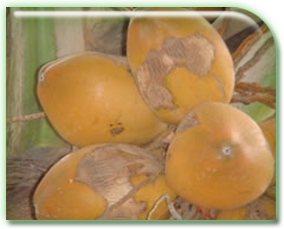 Coconut eriophyid mite Coconut eriophyid miteManurial and fertilizer recommendation (Soil application/tree/year)
Urea 1.3 kg
Super phosphate 2.0 kg
Muriate of potash* 3.5 kg
* Increased quantity is recommended to increase the plant resistance to the mite.
Neem cake application @ 5 kg
Organic manure (well rotten FYM) @ 50 kg
Micronutrients (Soil application / tree / year)
Borax 50 g
Gypsum 1.0 kg
Magnesium sulphate 500g
Grow sunnhemp as intercrop twice a year (Seed rate 30 kg/ha)
Spot application of ecofriendly Botanicals
| Round |
Eco-friendly Botanical |
Quantity / tree |
| 1. |
Azadirachtin 1% |
5 ml in one lit. of water |
| 2. |
Neem oil + Teepol |
30 ml in one lit. of water |
| 3. |
Azadirachtin 1% |
5 ml in one lit. of water |
Method of application
- The botanicals should be applied in the sequence indicated above at 45 days interval using a one litre hand sprayer. Rocker or Pedal sprayer can be used for spraying small trees.
- The spray should be applied at the crown region by a climber covering only the top six bunches during non rainy season.
- The bunches must be covered well by the spray fluid and approximately one litre of spray fluid may be required per tree
Precautions and safety measures
- Spraying should be avoided during windy season to prevent contamination.
- At the time of spraying, protective mask and clothing should be used.
- Wash face and hands cleanly with soap after spraying.
B. Disease management
I. Basal stem rot - Ganoderma lucidum
Cultural Method
- Apply Pseudomonas fluorescens (Pf1) @ 200 g/palm + Trichoderma viride @ 200 g/palm/year
- Apply 200g phosphobacteria and 200 g Azotobactor mixed with 50 Kg of FYM/palm
- Green manure crops must be raised and ploughed in situ
- Neem cake 5 kg/tree must be applied along with fertilizers
Chemical
- Aureofungin-sol 2 g + 1 g Copper sulphate in 100 ml water or 2 ml of Tridemorph in 100 ml water applied as root feeding. (The active absorbing root of pencil thickness must be selected and a slanting cut is made. The solution to be taken in a polythene bag or bottle and the cut end of the root should be dipped in the solution).
Forty litres of 1% Bordeaux mixture should be applied as soil drench around the trunk in a radius of 1.5 metre.
II. Bud rot - Phytophthora palmivora
The infective tissues from the crown region should be removed and protected with Bordeaux paste. Spray Bordeaux mixture at 1% or Copper oxy chloride 0.25 % on crown region as pre-monsoon spray. Spray Copper oxy chloride 0.25 % after the onset of monsoon.
III. Stem bleeding disease
The bark of the trunk should be removed in the bleeding area and Bordeaux paste should be applied in this area.
IV. Pencil point disease
Because of micronutrient deficiency, the stem will taper towards its tip with lesser number of leaves. The leaf size will be greatly reduced and the leaves will be pale and yellow in colour. Along with the recommended fertilizer dose, 225 g each of Borax, Zinc sulphate, Manganese sulphate, Ferrous sulphate, Copper sulphate and 10 g of Ammonium molybdate may be dissolved in 10 1 of water and poured in the basin of 1.5 m radius.
a. Preparation of 1% Bordeaux mixture
A quantity of 400 g of copper sulphate should be dissolved in 20 litres of water and 400 g of lime in another 20 litres of water separately. The copper sulphate solution should be added to the lime solution constantly stirring the mixture. Earthen or wooden vessels alone should be used and metallic containers should not be used. To find out whether the mixture is in correct proportion, a polished knife should be dipped in the mixture for one minute and taken out. If there is reddish brown deposit of copper, additional quantity of lime should be added till there is no deposit in the knife.
b. Preparation of Bordeaux paste
Take 200 g of Copper sulphate and dissolve it in one litre of water and 200 g of lime in one litre of water separately. Both are mixed simultaneously in a third vessel and the resultant mixture can be used as a paste.
Harvest and post harvest technology
Harvest 11-12 months old fully matured nuts at an interval of 30-45 days depending on the yield level of the garden. For household use keep the nuts in vertical direction. Dry copra either by sun drying or by using copra dryers. Store the copra at 5-6 % moisture content. Store the copra in polythene tar coated gunny bags.
For more details please click
Pests
The insect pests of the coconut palm are
Diseases
The diseases of the coconut palm are
SPECIAL PROBLEMS IN COCONUT
1. Rejuvenation of existing garden
The low yield in vast majority of gardens is due to thick population, lack of manuring and irrigation. These gardens could be improved if the following measures are taken.
- Thinning of thickly populated gardens: In the farmer’s holdings where thick planting is adopted, many trees give an yield of less than 20 nuts/palm/year. By cutting and removal of these trees, the yield could be increased. Besides, there is saving in the cost of cultivation and increase in net profit. After removal of low yielding trees, the populations should be maintained at 175 palms/ha.
- Ensuring adequate manuring and irrigation: The yield can be increased in the existing gardens when manuring + irrigation + cultural practice is adopted as per recommendation.
2. Pencil point disorder (Micronutrient deficiency)
Because of micronutrient deficiency, the stem will taper towards its tip with lesser number of leaves. The leaf size will be greatly reduced and the leaves will be pale and yellow in colour. Along with the recommended fertilizer dose, 225 g each of Borax, Zinc sulphate, Manganese sulphate, Ferrous sulphate, Copper sulphate and 10 g of Ammonium molybdate may be dissolved in 10 litres of water and poured in the basin of 1.8 m radius. This disorder can be corrected if noticed early. Severely affected palms may be removed and replanted with new seedlings.
3. Button shedding
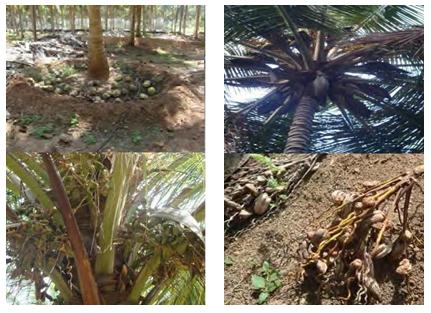 |
|
Button shedding |
Shedding of buttons and premature nuts may be observed to many reasons: Provide regular irrigation, requested nutrition to reduce the button shedding.
Barren nuts
Apply extra 2 kg of K2O with 200 g of Borax/palm over and above the usual dosage of fertilizer to correct the barren nuts in coconut.
- Regularly survey for pest and diseases
- Select seedlings 9 to 12 months after planting. Seedlings, which have germinated earlier, having good girth at collar and early splitting of leaflets, should be selected for planting.
TNAU MN mixture @ 1 kg/tree/year
(*Enriched FYM prepared at 1:10 ratio of the MN mixture and FYM, mixed at friable moisture and incubated for one month in shade).
Physiological Disorders
Deficiencies for nutrients such as nitrogen, phosphorus, potassium and micronutrients are very common in coconut cultivation. Symptoms are often observed in coconut gardens where the trees are not properly fertilized especially with organic manures.
Major Nutrients
1. Nitrogen (N) Deficiency
Symptoms
N deficiency is typically caused by insufficient N in the soil. Nitrogen deficiency begins as a uniform light green discoloration / yellowing (uniform chlorosis) of the oldest leaves. Yellowing starts from tip to base of the lower leaves and will proceed up. As the deficiency progresses, younger leaves will also become discoloured. Older leaves are golden yellow colour. Growth virtually stops when N deficiency is severe and become shedding of leaves.
Diagnostic Techniques
Nitrogen deficiency is easily diagnosed by symptoms alone, although leaf nutrient analysis can also be helpful. Nitrogen deficiency can be confused with Fe or S deficiency, although the chlorosis in those deficiencies is typically most severe on the youngest leaves. The reverse is true for N deficiency.
Management
Foliar application of 2% urea thrice at fortnightly interval or soil application of 1-2 kg urea / tree or root feeding of 1% urea (1 g/litre of water) 200 ml twice a year.
Deficiency Symptoms
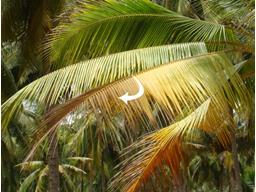
Uniform Chlorosis |

Yellowing Starts from Tip to Base |
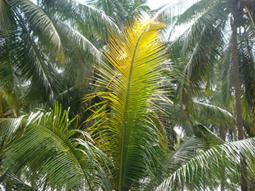
Yellowing of Leaves
|
2. Potassium (K) Deficiency
Symptoms
- Symptoms first appear on oldest leaves and later spread to young leaves.
- Translucent yellow or orange spots develop on leaflets (Yellowing of leaf margin).
- Older leaves are showing necrotic spotting as well curling of leaflet tips.
- Leaflets with necrotic areas along the margins which later wither
- The tree appears yellow and nicky, the trunk in slender with few short leaves.
Diagnostic Techniques
Visual symptoms alone may be sufficient for diagnosis of this disorder although leaf nutrient analysis may be helpful in distinguishing late stage K deficiency from manganese (Mn) deficiency. These two deficiencies can be extremely similar from a distance, but close examination should reveal characteristic spotting and marginal necrosis in K deficiency or necrotic streaking for Mn deficiency. Potassium deficiency symptoms are also more severe toward the leaf tip and are less so at the leaf base. The reverse is true for Mn deficiency.
Management
- Regular applications of K fertilizers will prevent K deficiency and treat palms already deficient. on sandy soils, or those having little cation exchange capacity, controlled-release K sources are much more effective than the easily leached water-soluble K sources.
- Application of resin coated K2SO4 @ 3 - 4 kg/tree, four times a year along with 2 kg MgSO4 / tree.
- Root feeding of 200ml of 1% KCL per tree thrice a year.
Deficiency Symptoms
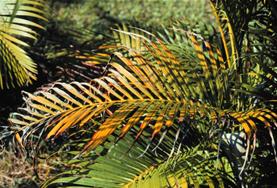
Leaf Declaration and Extensive Necrosis of Leaflet Margins and Tips |
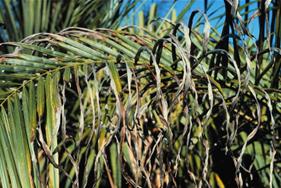
Leaflets Tip Necrosis and Curling |

Small Chlorotic and Necrotic New Leaves and Trunk Tapering |
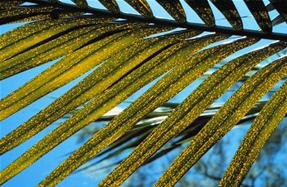
Translucent Yellow Orange Spotting |
3. Phosphorus Deficiency
Symptoms
- Purple coloration in leaves (In severe cases may leaves turn yellow before drying prematurely)
- Sluggish growth
- Leaves stay upright
- Premature leaf shedding
The growth, leaf size and leaf number reduced. The root growth is restricted if phosphorus deficiency is recorded. There are no clear visual symptoms of phosphorus deficiency other than stunting and decrease in yield.
Management
Foliar spray of DAP 2% twice at fortnightly interval or soil application of FYM 5kg/tree. Root feeding of 1% DAP 2 ml twice a year.
Deficiency Symptoms
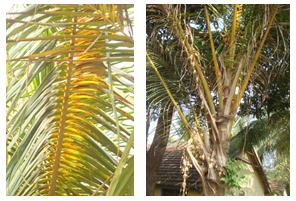
Yellowing and drying of leaves |
4. Sulphur Deficiency
Symptoms
Typical symptoms are yellowish-green or yellowish-orange leaflets. Old leaves remain green. Leaves droop as the stem becomes weak. In older palms, leaf number and size are reduced. Sometimes an apron of dead fronds develops around the stem due to weakness of the rachis. Nuts may fall prematurely. Copra is rubbery and of poor market quality.
Management
Soil application of gypsum 2 - 5 kg/tree/year. Root feeding of 0.2% (2g/litre of water) gypsum.
Deficiency Symptoms
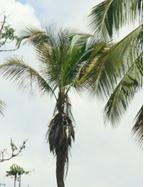
Apron of Dead Fronds Develops Around the Stem due to Weakness of the Rachis |

Leaf Number and Size Reduced |
Minor Nutrients
1.Boron (B) Deficiency
Symptoms
- Symptoms always occur on newly emerging leaves, and remain visible on these leaves as they mature and are replaced by younger leaves.
- One of the earliest symptoms of B deficiency on coconut palm is leaf wrinkling and manifested as sharply bent leaflet tips, commonly called “hook leaf”. Leaves have a serrated zigzag appearance.
- Other common symptom is the failure of newly emerging spear leaves to open normally. In a chronic stage, multiple unopened spear leaves may be visible at the apex of the canopy.
- Boron deficiency also occurs in inflorescence and nuts. The inflorescence and nuts are become necrotic.
Diagnostic Techniques
Boron deficiency symptoms are quite distinctive and are usually sufficient for diagnosis by themselves. Manganese deficiency produces symptoms similar to those of B deficiency, but no other common deficiency produces symptoms that could be confused with those of B deficiency. Because B deficiency is so transient in nature, the element is immobile within the palm (cannot move from one leaf to another), and deficiencies affect only leaf primordial developing within the bud area, leaf analysis is not particularly useful.
Management
Foliar spray of 0.2 % (2g in 1 lire of water) borax at the rate of 75 – 100 ml per seedling. Spraying is commonly practiced when coconut palms are at the nursery stage. 1 year old – Borax 5-10 g/plant per year 2-3 years old – Borax 15- 20 g/plant per year 4 years old and more – Borax 30 -50 g/plant per 2 years
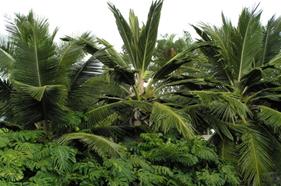
Leaf Fail to Open Properly |

Leaf Wrinkling and Distortion |
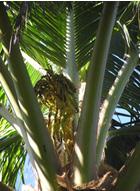
Necrotic Inflorescence |
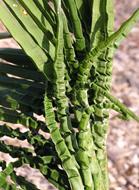
Severe Leaf Distortion |
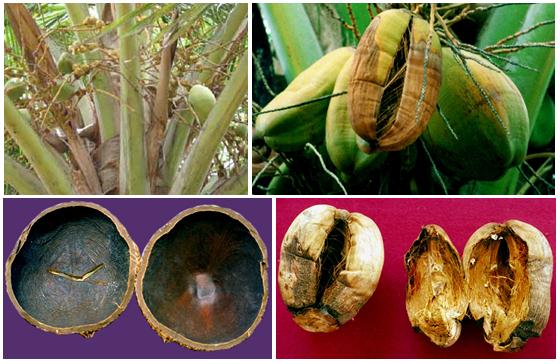
Boron deficiency symptoms |
2.Manganese (Mn) Deficiency
Symptoms
Manganese deficiency is very common on alkaline soils. The newest leaves of Mn deficient palms emerge chlorotic with longitudinal necrotic streaks. As the deficiency progresses, newly emerging leaflets appear necrotic and withered on all but basal portions of the leaflets. This withering results in a curling of the leaflets about the rachis giving the leaf a frizzled appearance (frizzle top). In severely Mn- deficient palms, growth stops and newly emerging leaves consist solely of necrotic petiole stubs.
Diagnostic Techniques
Visual symptoms may be sufficient to diagnose this disorder, but leaf nutrient analysis is also suggested, since symptoms of boron (B) deficiency can be similar. Late stage potassium (K) deficiency symptoms are virtually indistinguishable from those of Mn deficiency at a distance and close examination is required to look for characteristic longitudinal streaking and basal symptom distribution of Mn deficiency.
Management
Soil application of MnSO4 @ 25kg/ha
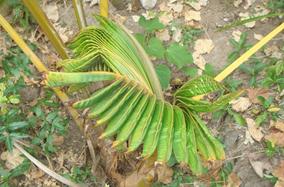 |
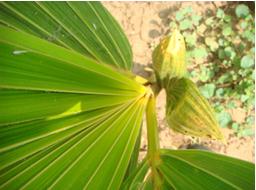 |
 |
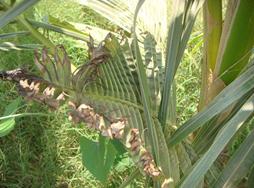 |
 |
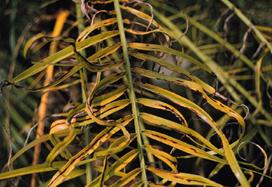 |
| Manganese (Mn) deficiency symptoms |
3.Magnesium (Mg) Deficiency
Symptoms
Magnesium deficiency appears on the oldest leaves of palms as broad chlorotic (yellow) bands along the margins with the central portion of the leaves remaining distinctly green. In severe cases leaflet tips may become necrotic. Older leaves become bronzed and dry appearance. Leaflets show necrosis and turn to reddish brown with translucent spots yellowing starts at the tip and spreads to the base.
Diagnostic Techniques
Visual symptoms alone are usually sufficient to diagnose Mg deficiency. Magnesium deficiency symptoms differ from those of K deficiency in that symptom severity of discoloration K- deficient leaves is usually orange to bronze, shading gradually to green at the base of the leaf, whereas Mg- deficient leaves have distinctly green leaf centers and bright lemon yellow to orange margins.
Management
Soil application of MgSO4 1-2 kg/tree/year. Root feeding of 200 ml of 0.2% MgSO4 twice a year.
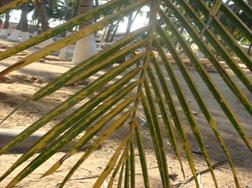 |
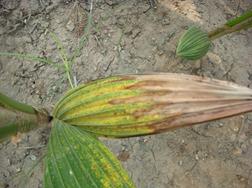 |
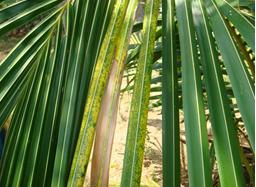 |
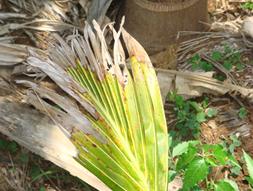 |
| Magnesium (Mg) deficiency symptoms |
4.Zinc (Zn) Deficiency
Symptoms
Zinc deficiency is characterized by formation of small leaves wherein the leaf size is reduced to 50%. Leaflets become chlorotic, narrow and reduced in length. In acute deficiency, flowering is delayed. Zinc deficiency will also lead to button shedding.
Management
Soil application of ZnSO4 @ 25kg/ha
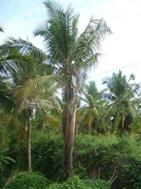
Reduced Leaf Size |
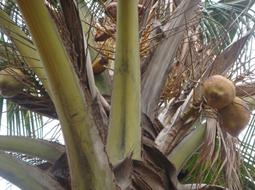
Small Nuts |
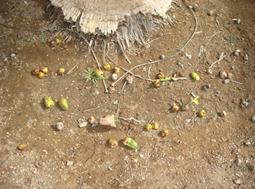
Button Shedding |
5. Iron (Fe) Deficiency
Symptoms
- Iron deficiency usually appears on palms growing in poorly aerated soils or those that have been planted too deeply. Water logged soils and deep planting effectively suffocate the roots and reduce their effectiveness in taking up nutrients such as Fe.
- The main symptom of iron deficiency is chlorosis or yellowing between the veins of new leaves (Uniform chlorotic new leaves as the deficiency progresses, the tips become necrotic and leaf size reduced).
Management
Application of Feso4 0.25 to 0.5 kg/tree/year
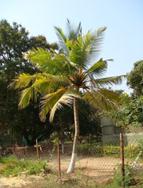 |
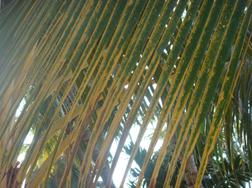 |
| Chloratic Leaves and Necrotic Tips |
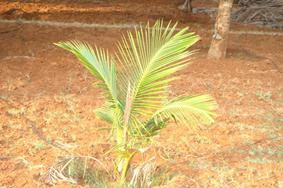 |
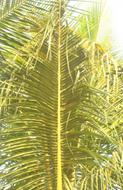 |
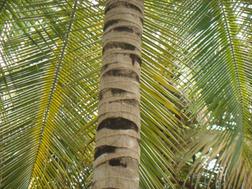 |
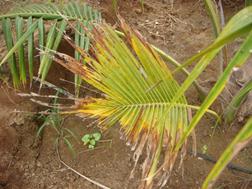 |
| Iron (Fe) deficiency symptoms |
6. Calcium (Ca) Deficiency
Symptoms
- Young leaves exhibit narrow white bands at margins
- Interveinal (chlorosis)
- Rusty appearance in leaf margin
- Rolling up of leaves
- Occurs only in acid soil
Management
Soil application of lime based on lime requirement and root feeding of 1% calcium nitrate
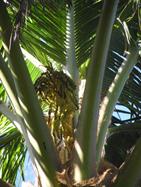
Death of Bud |
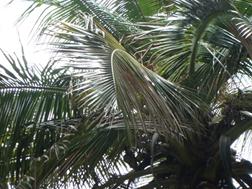
Rusty Appearance in Leaf Margin |
7.Copper (Cu) Deficiency
Symptoms
- Coppery bluish leaf
- Rolling of terminal leaves due to loss of turgor
- Leaves appear to be bleached grey
- Fail to produce flowers
Management
Soil application of CuSO4 @ 25 kg per ha.
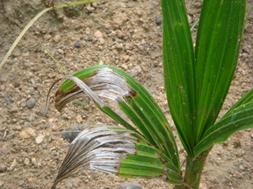
Coppery Bluish Leaf |
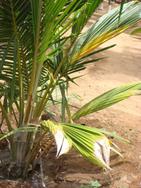
Leaves Appear to be Bleached Grey |

Rolling of Terminal Leaves |
8.Molybdenum (Mo) Deficiency
Symptoms
- Chlorotic leaf blade
- Small slender leaves
- Rosetted plants
- Occurrence of whip tail
Management
Root feeding of 0.05% (0.5g/litre of water) Sodium Molybdate
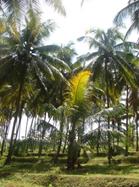 |
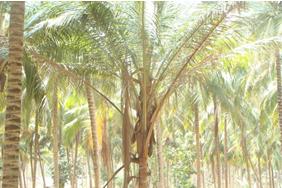 |
| Molybednum deficiency sysmptoms |
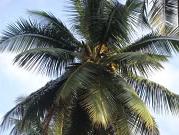
Mother palm with spherical or semi spherical crown
Market information
| Growing Districts |
Thiruvarur, Coimbatore, Kanyakumari, Tanjore |
| Major markets in Tamil Nadu |
Coimbatore, Tanjore, Chennai |
| Preferred varieties |
Tall Dwarf, Tall x Dwarf |
| Grade specification |
Colour, Nut Weight |
Updated on : 18.02.2014 |